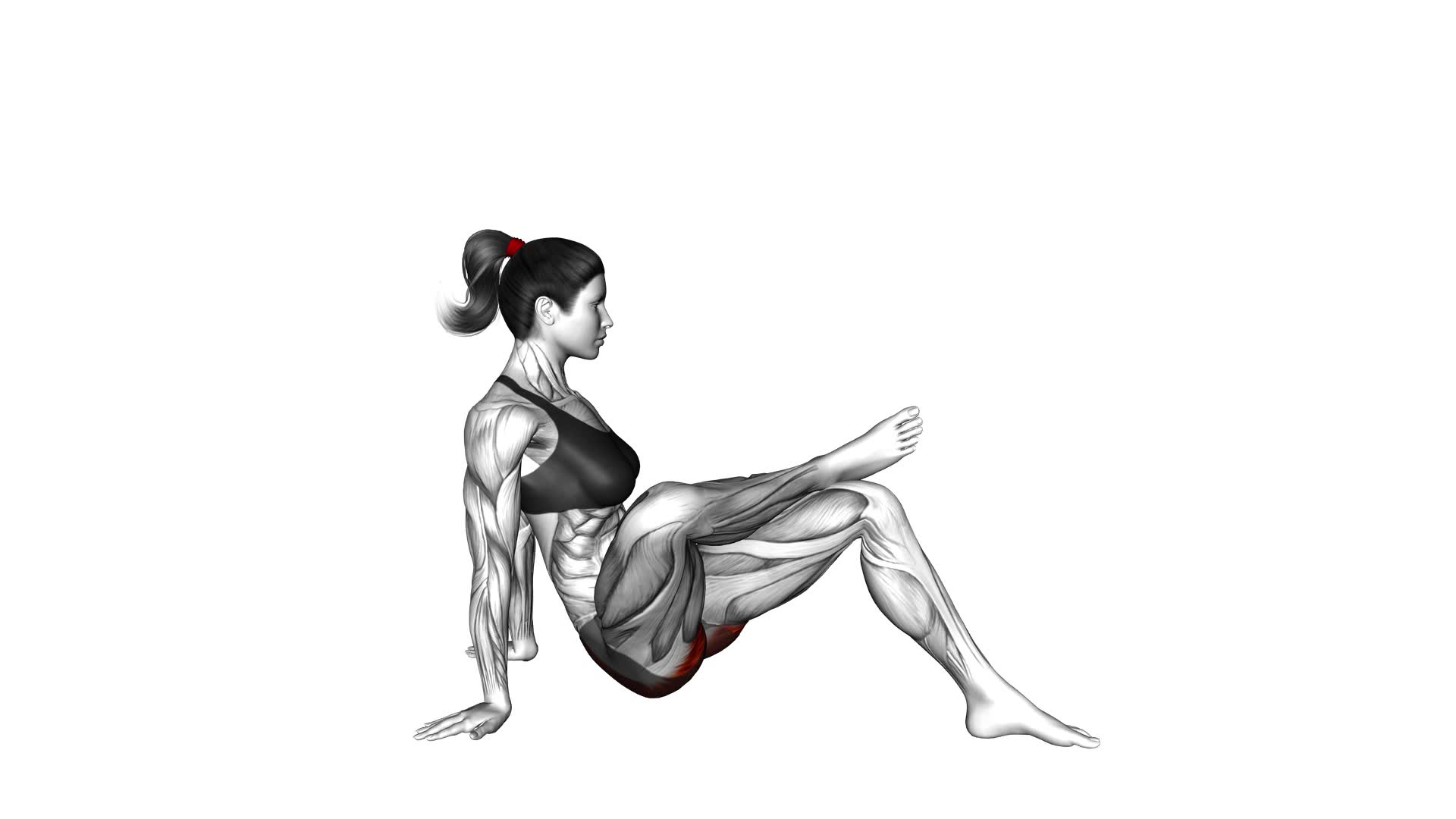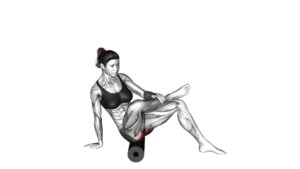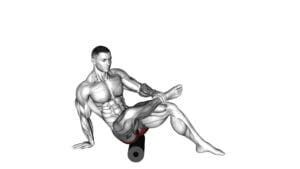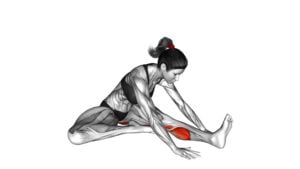Recumbent Hip External Rotator and Hip Extensor Stretch (CrossedLeg) (female) – Video Exercise Guide & Tips

Are you looking for an effective stretch to target your recumbent hip external rotators and hip extensors? Look no further!
Watch This Exercise Video
In this video exercise guide, we'll show you how to properly perform the crossed-leg recumbent hip stretch. Whether you're a beginner or an advanced practitioner, we have modifications for everyone.
Avoid common mistakes and incorporate this stretch into your fitness routine for improved hip mobility and flexibility.
Let's get started!
Key Takeaways
- The recumbent hip external rotator and hip extensor stretch targets hip muscles responsible for external rotation and extension.
- This stretch improves flexibility, stability, and lower body strength.
- It enhances athletic performance and reduces the risk of injury.
- The stretch also alleviates muscle imbalances and increases hip mobility and range of motion.
Benefits of the Recumbent Hip External Rotator and Hip Extensor Stretch
You can experience numerous benefits from performing the Recumbent Hip External Rotator and Hip Extensor Stretch. This exercise targets the hip muscles responsible for external rotation and extension, helping to improve flexibility, stability, and overall lower body strength. By incorporating this stretch into your routine, you can enhance your athletic performance, reduce the risk of injury, and alleviate muscle imbalances.
One of the key benefits of this stretch is its ability to increase hip mobility. By stretching the external rotators and hip extensors, you can improve your range of motion, allowing for smoother movements during activities such as running, jumping, and squatting. This increased mobility can also help to prevent tightness and discomfort in the hips and lower back.
Additionally, the Recumbent Hip External Rotator and Hip Extensor Stretch can be modified to accommodate beginners. If you're new to this exercise, you can start by performing the stretch with a smaller range of motion or using a lower resistance band. As you become more comfortable and flexible, you can gradually increase the intensity of the stretch.
Now that you understand the benefits of this exercise, let's explore the equipment needed to perform the Recumbent Hip External Rotator and Hip Extensor Stretch.
Equipment Needed for the Exercise
To perform the Recumbent Hip External Rotator and Hip Extensor Stretch, you'll need a resistance band and a mat. These pieces of equipment are essential for effectively targeting and stretching the hip external rotator and hip extensor muscles.
The resistance band provides the necessary resistance to engage and strengthen these muscles, while the mat offers a comfortable and supportive surface for performing the exercise.
The resistance band used for this exercise should be of appropriate tension and length to accommodate your fitness level and body size. It's important to choose a band that provides enough resistance to challenge your muscles, but not so much that it causes discomfort or strain. Additionally, the band should be long enough to allow for a full range of motion during the exercise.
Modifications can be made to the equipment used for this exercise based on individual needs and preferences. For example, if a resistance band isn't available, a cable machine or weights can be used as alternatives. Similarly, if a mat isn't accessible, a towel or carpeted surface can be used to provide some cushioning and support.
Remember to always choose equipment and modifications that align with your fitness level and abilities. Proper equipment selection and modifications can enhance the effectiveness and safety of the Recumbent Hip External Rotator and Hip Extensor Stretch.
Proper Form and Technique for the Stretch
To perform the recumbent hip external rotator and hip extensor stretch with proper form and technique, there are several key points to keep in mind.
First, ensure proper alignment and positioning of the body to target the intended muscles effectively.
Second, focus on breathing and relaxation to enhance the stretch and avoid unnecessary tension.
Lastly, be aware of common mistakes to avoid, such as overstretching or using incorrect form, to prevent injury and maximize the benefits of the stretch.
Alignment and Positioning
Achieving proper alignment and positioning is crucial for effectively performing the Recumbent Hip External Rotator and Hip Extensor Stretch (CrossedLeg) (female) exercise. To ensure you're in the correct position, follow these alignment techniques:
- Lie on your back with your legs extended.
- Bend your right knee and cross it over your left leg, placing your right foot on the floor.
- Keep your left leg straight and relaxed.
- Place your left hand on your left thigh to provide gentle pressure.
- Slowly bring your right knee towards the floor, feeling a stretch in your hip and buttocks.
Proper alignment not only helps prevent injury but also allows for optimal muscle activation during the stretch. Ensure you maintain proper form and technique throughout to maximize the benefits of this exercise.
Breathing and Relaxation
As you lie on your back with your legs extended and your right knee bent and crossed over your left leg, it's important to focus on your breathing and relaxation techniques during the Recumbent Hip External Rotator and Hip Extensor Stretch (CrossedLeg) (female) exercise.
Proper breathing techniques can help you relax your body and enhance the effectiveness of the stretch. Take deep breaths in through your nose, filling your lungs with air, and exhale slowly through your mouth, letting go of any tension in your muscles.
As you breathe, consciously relax your body, releasing any tightness or stress. Relaxation techniques such as visualization or progressive muscle relaxation can also be beneficial in achieving a deeper stretch and promoting overall relaxation.
Remember to stay present and mindful throughout the exercise, focusing on your breath and allowing your body to relax.
Common Mistakes to Avoid
During the Recumbent Hip External Rotator and Hip Extensor Stretch (CrossedLeg) (female) exercise, it's crucial to maintain proper form and technique to avoid common mistakes. To ensure you're performing the stretch correctly and effectively, here are some common mistakes to avoid:
- Rounding your back: Keep your spine straight and avoid rounding your back to prevent strain and injury.
- Allowing your knee to collapse inward: Keep your knee in line with your hip and ankle to maintain proper alignment and target the correct muscles.
- Holding your breath: Remember to continue breathing throughout the stretch to promote relaxation and prevent tension buildup.
- Overstretching: Avoid pushing beyond your comfortable range of motion to prevent overstretching and potential muscle tears.
- Neglecting the opposing side: Remember to perform the stretch on both sides to maintain balance and prevent muscle imbalances.
Modifications for Beginners and Advanced Practitioners
Now let's explore some modifications that cater to different skill levels.
If you're a beginner, we've some helpful tips to make the stretch more accessible for you.
On the other hand, if you're an advanced practitioner, we've variations that will challenge you and allow you to progress in difficulty.
Whether you're just starting out or looking to take your practice to the next level, we've got you covered.
Beginner Modification Tips
To modify this exercise for beginners, start by using a cushion or folded towel to support your hips. This will provide additional comfort and stability as you perform the stretch.
Here are some other beginner modification tips to consider:
- Start with a smaller range of motion: Gradually increase the depth of the stretch as you become more comfortable.
- Use a resistance band: Place a resistance band around your legs to provide assistance and support during the stretch.
- Try alternative stretches: If this stretch feels too challenging, you can try alternative exercises such as seated hip external rotations or standing hip stretches.
- Focus on proper form: Pay attention to your alignment and make sure to engage your core muscles throughout the stretch.
- Listen to your body: If you experience any pain or discomfort, ease off the stretch and consult a healthcare professional.
Advanced Practitioner Variations
To advance your practice, incorporate challenging variations of the recumbent hip external rotator and hip extensor stretch. For advanced modifications, you can try adding resistance to the exercise by using a resistance band or ankle weights. This will increase the intensity and target the muscles even more effectively.
Another variation is to perform the stretch on an unstable surface, such as a balance board or BOSU ball. This will further engage your core and challenge your balance and stability.
When performing the stretch, focus on technique refinement by maintaining proper form and alignment throughout the movement. Keep your back straight, shoulders relaxed, and engage your glutes and core muscles.
Remember to breathe deeply and hold the stretch for 20-30 seconds on each side.
Progressing in Difficulty
To progress in difficulty, beginners and advanced practitioners can incorporate modifications into their recumbent hip external rotator and hip extensor stretch routine. By using progression techniques, you can challenge yourself and continue to improve your flexibility and strength.
Here are some modifications to try:
- Increase the duration of the stretch gradually, aiming for longer holds each time.
- Use a resistance band to add tension and deepen the stretch.
- Experiment with different angles and positions to target specific muscles.
- Incorporate dynamic movements, such as pulsing or bouncing, to activate the muscles further.
- Combine the stretch with other exercises, like lunges or squats, to engage multiple muscle groups.
Remember to always start with a proper warm-up to prepare your body for the stretch.
Now, let's move on to the next section and learn about common mistakes to avoid.
Common Mistakes to Avoid
Avoid the common mistake of rounding your lower back during the Recumbent Hip External Rotator and Hip Extensor Stretch (CrossedLeg) exercise. Rounding your lower back can lead to injuries and reduce the effectiveness of the stretch. To avoid this mistake, it's important to maintain proper form throughout the exercise.
When performing the Recumbent Hip External Rotator and Hip Extensor Stretch (CrossedLeg), start by lying on your back with both legs bent. Cross one leg over the other, placing the ankle on the opposite knee. From this position, gently press the crossed knee away from your body, feeling a stretch in the hip and glute muscles.
To maximize the effectiveness of the stretch and avoid injuries, keep your lower back flat against the ground. Avoid lifting your hips off the ground or allowing your lower back to round. Engage your core muscles to stabilize your lower back and maintain proper alignment.
Remember to breathe deeply and relax into the stretch, allowing the muscles to release tension. Hold the stretch for 20-30 seconds on each side, repeating it 2-3 times.
Tips for Incorporating the Stretch Into Your Fitness Routine
To incorporate the Recumbent Hip External Rotator and Hip Extensor Stretch (CrossedLeg) into your fitness routine, focus on maintaining proper form and engaging your core muscles. This stretch is a great addition to your routine as it targets the hip extensors and external rotators, helping to improve flexibility and mobility in the hips.
Here are some tips to help you effectively incorporate this stretch into your fitness routine:
- Begin by lying on your back with your knees bent and feet flat on the floor.
- Cross one ankle over the opposite knee, creating a figure-four shape with your legs.
- Use your hands to gently pull your crossed leg toward your chest, feeling a stretch in the hip of the crossed leg.
- Hold the stretch for 20 to 30 seconds, focusing on deep breathing and relaxing into the stretch.
- Repeat on the other side, crossing the opposite ankle over the opposite knee.
Incorporating this stretch into your fitness routine can help improve hip flexibility and reduce the risk of injury. Remember to listen to your body and never push yourself beyond your limits. Make sure to warm up before attempting this stretch and consult with a fitness professional if you have any concerns or limitations.
Frequently Asked Questions
What Are the Potential Risks or Side Effects of Performing the Recumbent Hip External Rotator and Hip Extensor Stretch?
When performing the recumbent hip external rotator and hip extensor stretch, it's important to be aware of the potential risks and side effects. These may include muscle strain or discomfort in the hip and lower back area.
It's crucial to listen to your body and not push yourself too hard during the stretch, as this could lead to injury.
Always consult with a healthcare professional before attempting any new exercise to ensure it's safe for you.
How Long Should Each Repetition of the Stretch Be Held for Maximum Effectiveness?
To achieve maximum effectiveness, it's important to hold each repetition of the stretch for an appropriate amount of time. This ensures that the muscles are properly stretched and can benefit from the exercise.
However, it's also important to consider the potential risks associated with this stretch. It's always recommended to consult with a healthcare professional or a qualified fitness trainer to determine the appropriate duration for holding each repetition of the stretch to avoid any potential injuries or side effects.
Can This Stretch Be Performed by Individuals With Previous Hip Injuries or Conditions?
Yes, individuals with previous hip injuries or conditions may still be able to perform this stretch, but it's important to consult with a healthcare professional first. They can provide guidance on modifications or alternative stretches that may be more suitable for your specific condition.
Prioritizing safety and proper form is crucial to prevent further injury and ensure maximum effectiveness of the stretch.
Are There Any Alternative Stretches or Exercises That Can Target the Same Muscle Groups?
If you're looking for alternative exercises that target the same muscle groups, there are a few options you can try.
One option is the seated hip external rotation exercise, which can help strengthen the same muscles.
Another alternative is the standing hip extension exercise, which focuses on the hip extensors.
These exercises can be modified for beginners by starting with lighter weights or shorter durations.
Remember to consult with a professional before starting any new exercise routine.
Can This Stretch Help Improve Flexibility and Range of Motion in Activities Such as Running or Dancing?
This stretch can definitely help improve your flexibility and range of motion in activities like running or dancing. By targeting the hip external rotators and hip extensors, it allows for better movement and increased mobility in your joints.
This can ultimately lead to improved athletic performance and reduce the risk of injuries. Additionally, incorporating this stretch into your routine can provide benefits for overall joint health, keeping you strong and ready for any physical activity.
Conclusion
Incorporating the recumbent hip external rotator and hip extensor stretch into your fitness routine can provide numerous benefits, including increased flexibility and improved hip mobility.
By properly following the correct form and technique, you can effectively stretch and strengthen these important muscle groups.
Remember to start with the appropriate modifications if you're a beginner, and always avoid common mistakes to prevent injury.
Make this stretch a regular part of your exercise regimen to reap its full benefits.

Author
Years ago, the spark of my life’s passion ignited in my mind the moment I stepped into the local gym for the first time. The inaugural bead of perspiration, the initial endeavor, the very first surge of endorphins, and a sense of pride that washed over me post-workout marked the beginning of my deep-seated interest in strength sports, fitness, and sports nutrition. This very curiosity blossomed rapidly into a profound fascination, propelling me to earn a Master’s degree in Physical Education from the Academy of Physical Education in Krakow, followed by a Sports Manager diploma from the Jagiellonian University. My journey of growth led me to gain more specialized qualifications, such as being a certified personal trainer with a focus on sports dietetics, a lifeguard, and an instructor for wellness and corrective gymnastics. Theoretical knowledge paired seamlessly with practical experience, reinforcing my belief that the transformation of individuals under my guidance was also a reflection of my personal growth. This belief holds true even today. Each day, I strive to push the boundaries and explore new realms. These realms gently elevate me to greater heights. The unique combination of passion for my field and the continuous quest for growth fuels my drive to break new ground.







